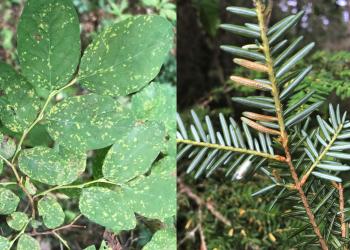Hemlock-Blueberry Rust
Naohidemyces vaccinii (Jørst.) S. Sato, Katsuya & Y. Hirats.
Host(s) in Alaska:
western hemlock (Tsuga heterophyla) and blueberry (Vaccinium spp.)
Habitat(s): western hemlock needles and blueberry leaves
General Distribution in Alaska: Southeast Alaska
This disease has been common the last several years and probably benefits from average to above average summer precipitation. This year we noticed that infected needles were cast from western hemlock soon after fruiting structures developed. Early needle shed of infected needles shortens the window for infection from hemlock to blueberry and could limit damage from this disease despite cooccurrence of both hosts across coastal Alaska. Disease may become more prevalent when precipitation aligns with spore dispersal from hemlock to blueberry. Hemlock-blueberry rust damage is usually not severe, nor does it cause lasting or significant damage to western hemlock.
2024 Ground Detection Survey Observations: 20 records between Haines and Ketchikan in Southeast Alaska.
Hemlock-blueberry rust was previously considered a disease of minor importance, difficult to find on both blueberry leaves and hemlock needles. However, there has been notable disease on both new western hemlock needles and blueberry leaves in Southeast Alaska since 2019 (see Detection Map). In 2021, we sequenced DNA from samples collected near Juneau, Wrangell Island, and Mitkof Island. All of our sequences showed consistent base pair differences with the Naohidemyces vaccinii voucher specimen in GenBank. With continued collection and evaluation of spore morphology, we hope to learn more about the causal fungus in Alaska compared to related species elsewhere in North America and Europe.
The disease is caused by a heterocyclic rust fungus (Naohidemyces vaccinii) with one lifecycle stage on hemlock needles (rarely on cones) and the other stage on several species of blueberry (Vaccinium spp.). Another needle rust of western and mountain hemlocks, Melampsora epitea f. sp. tsugae, is also present in Alaska, which has lifecycle stages on willow.
In summer, current-year hemlock needles become infected by spores produced on blueberry leaf-litter (for deciduous Vaccinium spp.) or on persistent leaves (for evergreen Vaccinium spp.). Orange or yellow pustules form on the underside of hemlock needles. Pustules occur in two rows, on either side of the midrib vein of the needle. Infected needles turn yellow. Hemlocks are not usually heavily infected, thus new shoots often have a scattering of diseased yellow needles among healthy green needles. Infected needles turn yellow and die, and are shed prematurely. Injury to infected trees is generally negligible, perhaps slightly reducing growth. The generally low occurrence of this rust is surprising given the great abundance of western hemlock and blueberries in coastal Alaska. Control is not usually warranted. On occasion, heavier infection is observed on hemlock shoots, infecting 50-75% of new hemlock needles.
Life cycle: The fungus overwinters on infected blueberry foliage. In early-summer, basidiospores are released from infected blueberry leaves on the ground (and from everygreen blueberry leaves, where present) to infect elongating hemlock shoots. Next, pycnia/spermagonia (sexual spores stage) and aecia (fruiting bodies) are formed on new hemlock needles, releasing aeciospores that infect blueberry leaves. A repeating spore (urediospores) stage on infected blueberry leaves, facilitating disease buld-up during the growing season. If everygreen blueberry hosts are present, the disease can persist without the hemlock host, persisting with the repeating urediospore stage.
Rust-eating midges
Content prepared by Robin Mulvey, Forest Health Protection, robin.mulvey@usda.gov. Information from the book Insects and Disease of Alaskan Forests has been included.


















